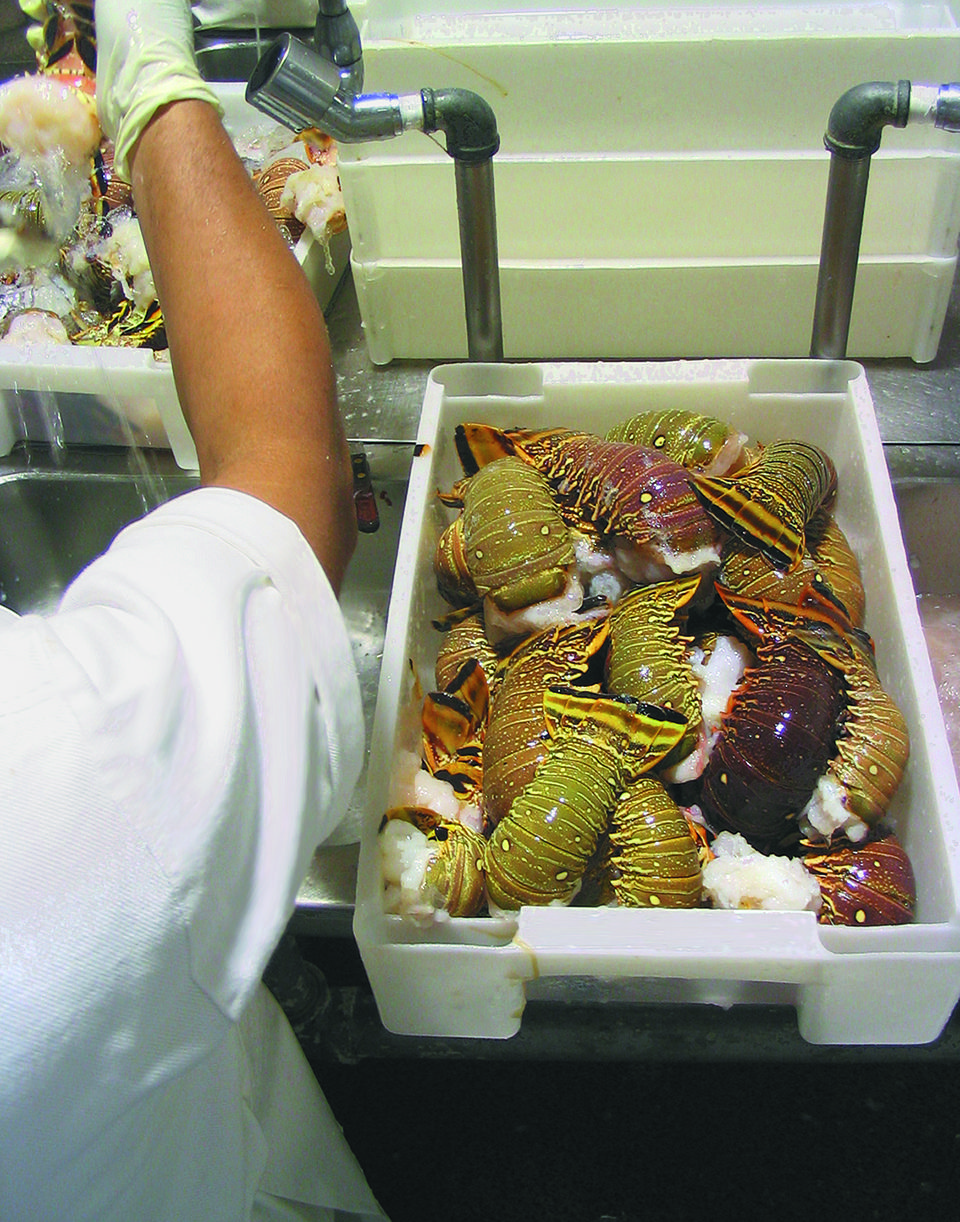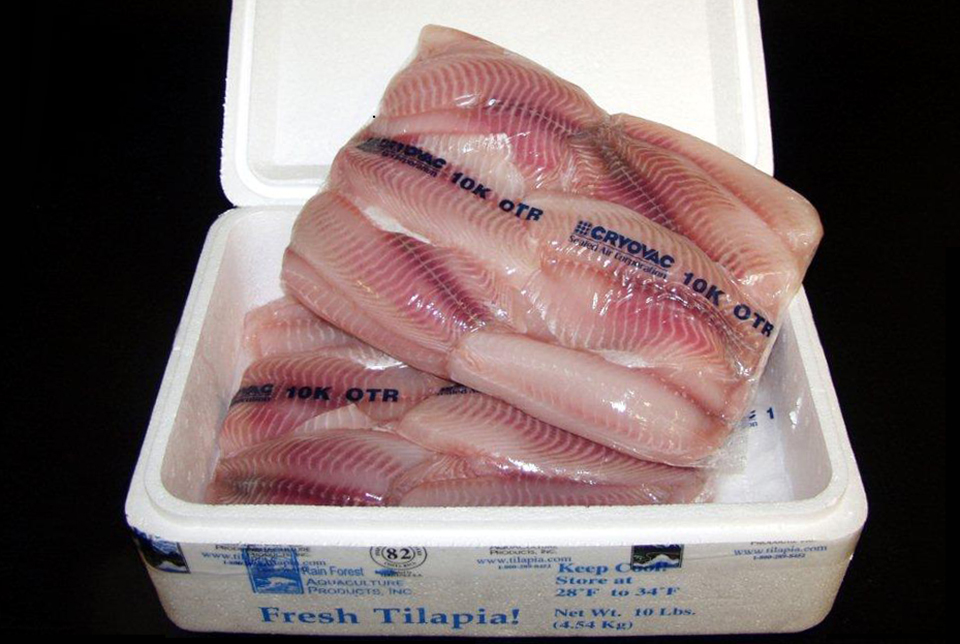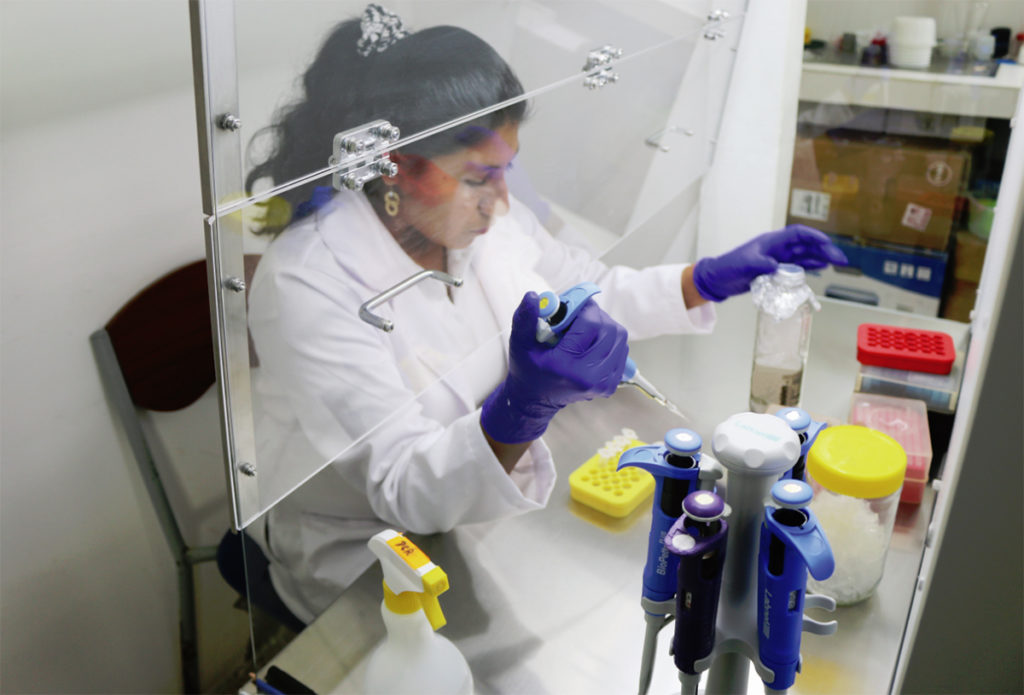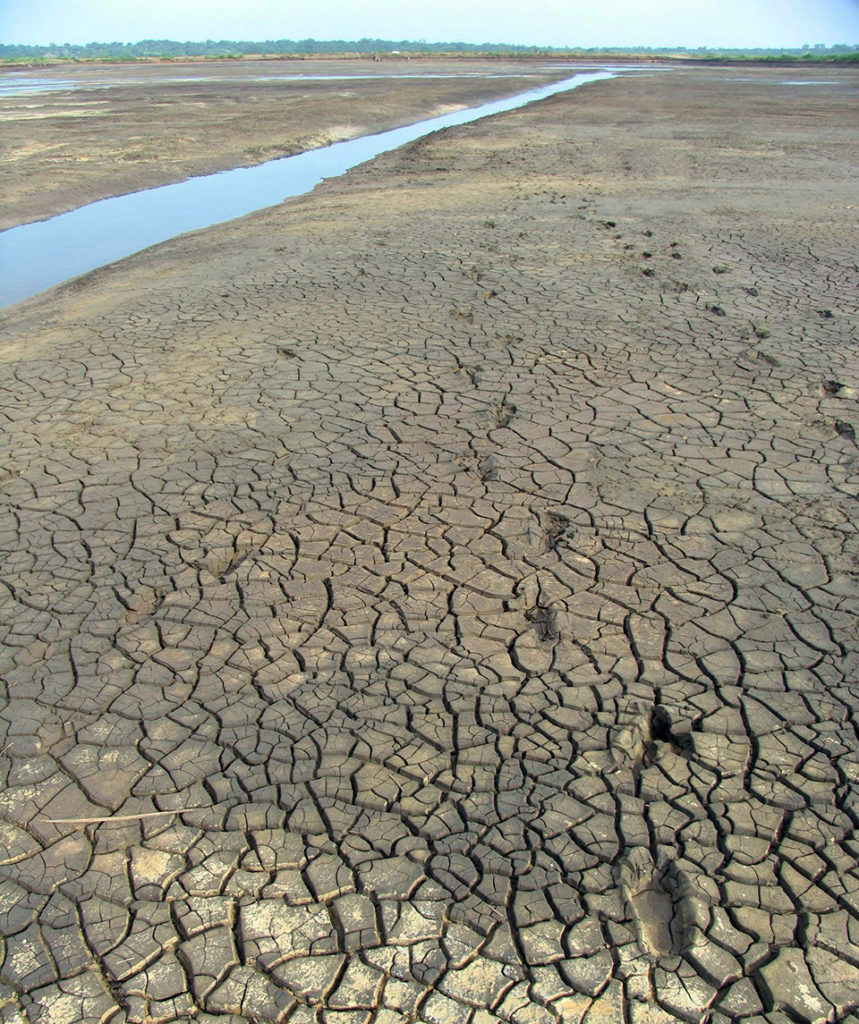Strong oxidant could be applied in a variety of seafood processes

Aqueous chlorine is widely used in seafood processing to control microbial growth. However, its bactericidal activity decreases in alkaline conditions and/or at high levels of organic matter. Owing to health concerns regarding the trihalomethanes, haloacetic acids, chloroform, chlorophenols, and other chlorination reaction products generated during interactions of organics with aqueous chlorine, efforts have been made to identify viable alternatives to its use.
Chlorine dioxide
Chlorine dioxide is one of the most promising substitutes for chlorine. It is a strong oxidant that could be applied in a variety of seafood processes. An excellent sanitizer, chlorine dioxide has been shown to be seven times more potent than aqueous chlorine in killing bacteria and viruses in some applications. Furthermore, fewer potentially toxic reaction products result from treatment of organic matter with chlorine dioxide.
Since the bactericidal activity of chlorine dioxide is not affected by alkaline conditions and/or high levels of organic matter, it maintains bactericidal action far longer than chlorine. Chlorine dioxide is less reactive than aqueous chlorine in interactions with organic compounds such as unsaturated fatty acids, their methyl esters, and tryptophan and its derivatives. Consequently, fewer potentially toxic/mutagenic reaction products are formed.
When chlorine dioxide reacts with aqueous contaminants, it is usually reduced to chlorite ions. Chlorine dioxide-manufacturing systems are also easy to install, operate, and maintain.
Potential processing aid
Chlorine dioxide could serve as a processing aid for seafood, poultry, red meat, and peeled vegetables and fruits to enhance freshness and extend shelf life. On March 3, 1995, the United States Food and Drug Administration amended U.S. food additive regulations to provide a 3-ppm residual chlorine dioxide level for controlling microbial populations in poultry-processing water that contacts whole poultry carcasses. Although chlorine dioxide is not approved for treatment of seafood in the United States because of the lack of toxicological and safety information, the chemical’s use may be permitted in other countries.
Several studies have shown that chlorine dioxide is effective in reducing certain vegetative and spore-forming bacterial populations such as Escherichia coli 0157:H7, Listeria monocytogenes, Staphylococcus aureus, Bacillus subtilis, Sarcina sp., Chloropseudomonas sp. and Bacillus brevis. Table 1 outlines the effects of varying concentrations of chlorine dioxide on the reduction of L. monocytogenes. The compound has also been demonstrated to inactivate oocysts of the parasite Cryptosporidium parvum.
Flick, Average reduction of Listeria monocytogenes, Table 1
| L. monocytogenes | Chlorine Dioxide (ppm) | Reduction (%) |
|---|
L. monocytogenes | Chlorine Dioxide (ppm) | Reduction (%) |
|---|---|---|
| 3.4 x 103 | 40 | 89 |
| 100 | 97 | |
| 200 | 100 | |
| 400 | 100 | |
| 2.4 x 106 | 40 | 84 |
| 100 | 85 | |
| 200 | 87 | |
| 400 | 90 |
Aquaculture applications
One of the most destructive pathogens in salt water aquaculture, Vibrio parahaemolyticus, has been effectively inactivated at the relatively low concentration of 285 grams chlorine dioxide per liter water. When chlorine dioxide was introduced at levels below 47 grams per liter to a sea water aquaculture system containing shrimp, the growth of V. parahaemolyticus was inhibited and there was no effect on the shrimp. This pathogen is of special interest due to its short generation time and threat to public health, as several Vibrio strains cause human gastroenteritis.
Effects on lipid oxidation, vitamins
In research, Atlantic salmon (Salmo salar) and red groupers (Epinephelus morio) were treated with aqueous chlorine dioxide concentrations of 20, 40, 100 and 200 ppm in ice-cold 3.5 percent brine for five minutes. Thiobarbituric acid values showed dose-related increases at 100 and 200 ppm over the control and the 20 ppm group, but the differences were minimal.
Monounsaturated and polyunsaturated fatty acid compositions did not differ in percentage when compared to the controls, although some small differences occurred with some individual fatty acids. Omega 3 fatty acids, which are important to human health, were not affected.
The effects of chlorine dioxide on vitamins are shown in Table 2. Thiamin levels in both red groupers and Atlantic salmon were reduced by approximately half. Riboflavin levels were slightly reduced in salmon, but decreased 25 percent in red groupers. Niacin levels in both species were relatively unchanged.
Flick, Effects of chlorine dioxide solutions, Table 2
| Chlorine Dioxide (ppm) | Thiamin (µg/10-g fish) | Riboflavin (µg/10-g fish) | Niacin (µg/10-g fish) |
|---|
Chlorine Dioxide (ppm) | Thiamin (µg/10-g fish) | Riboflavin (µg/10-g fish) | Niacin (µg/10-g fish) |
|---|---|---|---|
| Atlantic salmon | |||
| Control | 16.3 ± 1.8 | 25.6 ± 1.9 | 2.36 ± 0.15 |
| 20 | 7.20 ± 0.40 | 17.4 ± 2.3 | 2.25 ± 0.15 |
| 40 | 9.60 ± 0.50 | 14.9 ± 2.2 | 2.25 ± 0.22 |
| 80 | 7.20 ± 0.40 | 14.2 ± 0.7 | 2.14 ± 0.16 |
| 100 | 6.70 ± 0.70 | 18.2 ± 3.3 | 2.18 ± 0.22 |
| Red grouper | |||
| Control | 11.3 ± 0.6 | 8.78 ± 1.51 | 4.76 ± 0.17 |
| 20 | 8.76 ± 0.80 | 8.61 ± 0.46 | 4.57 ± 0.36 |
| 40 | 9.37 ± 0.56 | 7.28 ± 1.01 | 4.49 ± 0.33 |
Effects on finfish
Varying results were achieved when chlorine dioxide was applied to various fish products (Table 3). After seven days of storage at 5 degrees-C, log10 reductions ranged from less than 90 percent to 99 percent. The most significant changes were observed in whole salmon muscle, whole groupers, and salmon fillets. Only minimal changes were observed in the grouper fillets and whole salmon. It would have been useful if the storage temperature were reduced to 0-2 degrees-C, the recommended temperature to maintain high quality.
Flick, Changes in microbial populations, Table 3
| Sample | Chlorine Dioxide (ppm) | log10 CFU/g Day 0 | log10 CFU/g Day 3 | log10 CFU/g Day 7 |
|---|
Sample | Chlorine Dioxide (ppm) | log10 CFU/g Day 0 | log10 CFU/g Day 3 | log10 CFU/g Day 7 |
|---|---|---|---|---|
| Control | 4.82 | 6.34 | 7.95 | |
| 20 | 4.77 | 6.21 | 7.76 | |
| 40 | 4.76 | 5.93 | 7.62 | |
| 100 | 4.55 | 5.99 | 7.45 | |
| 200 | 4.28 | 5.66 | 7.49 | |
| Control | 4.38 | 5.13 | 7.58 | |
| 20 | 4.02 | 4.93 | 7.07 | |
| 40 | 3.79 | 4.94 | 6.96 | |
| 100 | 3.74 | 4.62 | 6.91 | |
| 200 | 3.31 | 4.75 | 6.47 | |
| Control | 5.34 | 6.39 | 8.03 | |
| 20 | 4.42 | 5.99 | 7.71 | |
| 40 | 4.65 | 5.77 | 7.89 | |
| 100 | 4.06 | 5.51 | 7.16 | |
| 200 | 4.13 | 5.13 | 7.35 | |
| Control | 3.32 | 4.76 | 6.44 | |
| 20 | 3.18 | 4.76 | 6.26 | |
| 40 | 3.36 | 4.82 | 6.13 | |
| 100 | 2.93 | 4.63 | 6.02 | |
| 200 | 2.75 | 4.58 | 6.05 | |
| Control | 3.96 | 5.29 | 7.21 | |
| 20 | 2.94 | 4.38 | 6.55 | |
| 40 | 2.71 | 4.06 | 6.11 | |
| 100 | 1.96 | 3.34 | 5.50 | |
| 200 | 1.89 | 3.44 | 5.7 |
Effects on shellfish
In further testing, muscle tissues of shrimp (Penaeus setiferus), crawfish (Procambarus clarkii) and scallops (Aequipecten gibbus) were exposed to varying concentrations of chloride dioxide. The shrimp and crawfish were treated for two minutes at 15.6 degrees-C, while the scallops were immersed in ice-cold 3.5 percent brine for five minutes and stored at 5 degrees-C.
Shrimp and crawfish tail meat aerobic plate counts were reduced approximately 90 to 99 percent after 14 and 21 days of 20, 30 and 40 ppm exposure to chlorine dioxide (Table 4). The same magnitudes of reduction were observed with the psychrotrophic plate counts.
Flick, Changes in microbial populations on shellfish, Table 4
| Day | Aerobic plate count log10 cfg g-1 0 ppm | Aerobic plate count log10 cfg g-1 | Aerobic plate count log10 cfg g-1 20 ppm | Aerobic plate count log10 cfg g-1 30 ppm | Aerobic plate count log10 cfg g-1 40 ppm |
|---|
Day | Aerobic plate count log10 cfg g-1 0 ppm | Aerobic plate count log10 cfg g-1
| Aerobic plate count log10 cfg g-1 20 ppm | Aerobic plate count log10 cfg g-1 30 ppm | Aerobic plate count log10 cfg g-1 40 ppm |
|---|---|---|---|---|---|
| Shrimp tail | |||||
| 0 | 3.74 | 3.63 | 2.86 | 2.78 | 2.36 |
| 7 | 3.38 | 2.88 | 2.58 | 2.51 | 2.15 |
| 14 | 5.29 | 4.48 | 4.25 | 3.88 | 3.64 |
| 21 | 6.10 | 6.11 | 5.15 | 4.84 | 4.73 |
| Crawfish tail | |||||
| 0 | 4.97 | 4.83 | 4.48 | 4.48 | 4.10 |
| 7 | 4.61 | 4.24 | 4.10 | 3.94 | 3.64 |
| 14 | 5.29 | 5.20 | 5.18 | 4.10 | 3.82 |
| 21 | 6.11 | 5.86 | 5.86 | 3.64 | 4.92 |
| Day | Psychrotophic plate count log10 cfg -1 0 ppm | Psychrotophic plate count log10 cfg -1 10 ppm | Psychrotophic plate count log10 cfg -1 20 ppm | Psychrotophic plate count log10 cfg -1 30 ppm | Psychrotophic plate count log10 cfg -1 40 ppm |
| Shrimp tail | |||||
| 0 | 3.28 | 3.48 | 2.61 | 2.44 | 2.10 |
| 7 | 3.89 | 3..35 | 2.85 | 2.81 | 2.51 |
| 14 | 5.43 | 4.76 | 4.56 | 4.35 | 3.87 |
| 21 | 6.62 | 6.37 | 5.32 | 5.07 | 4.76 |
| Crawfish tail | |||||
| 0 | 4.56 | 4.43 | 3.92 | 3.93 | 3.64 |
| 7 | 4.77 | 4.56 | 4.26 | 4.14 | 3.82 |
| 14 | 6.62 | 5.42 | 5.43 | 4.26 | 3.86 |
| 21 | 7.39 | 6.31 | 6.03 | 5.68 | 5.10 |
(Editor’s Note: This article was originally published in the April 2005 print edition of the Global Aquaculture Advocate.)
Now that you've reached the end of the article ...
… please consider supporting GSA’s mission to advance responsible seafood practices through education, advocacy and third-party assurances. The Advocate aims to document the evolution of responsible seafood practices and share the expansive knowledge of our vast network of contributors.
By becoming a Global Seafood Alliance member, you’re ensuring that all of the pre-competitive work we do through member benefits, resources and events can continue. Individual membership costs just $50 a year.
Not a GSA member? Join us.
Author
-

George J. Flick, Jr., Ph.D.
Food Science and Technology Department
Virginia Tech/Virginia Sea Grant (0418)
Blacksburg, Virginia 24061 USA
Tagged With
Related Posts

Intelligence
An examination of seafood packaging
Some substances can migrate from plastics and other seafood packaging materials into the product. Even if the substances are not harmful, they can affect the flavor and acceptability of the food.

Health & Welfare
Asepsis key to prevent contamination in shrimp hatcheries
Maintaining biosecurity and asepsis in larval shrimp production is a key component of the production chain in Ecuador, which requires the production of 5.5 billion larvae monthly from 300-plus hatcheries.

Responsibility
Drying, liming, other treatments disinfect pond bottoms
The traditional way of destroying organisms in pond bottoms is thorough dry-out for a week or longer. Fish toxicants and liming can kill unwanted parasites.

Health & Welfare
Hyper-intensive nursery systems offer advantages for shrimp culture
Hyper-intensive nursery systems for juvenile shrimp production present significant opportunities for shrimp farmers to increase profits. Nursery culture results in strong, healthy and uniform juveniles with great potential for compensatory growth when stocked in production ponds. Nurseries produce a maximum number of juveniles of a desired weight, and their use can reduce production costs by shortening time in growout ponds and increasing pond efficiency through additional cycles per year.


